tires CHRYSLER PT CRUISER 2010 1.G User Guide
[x] Cancel search | Manufacturer: CHRYSLER, Model Year: 2010, Model line: PT CRUISER, Model: CHRYSLER PT CRUISER 2010 1.GPages: 60, PDF Size: 6.19 MB
Page 29 of 60
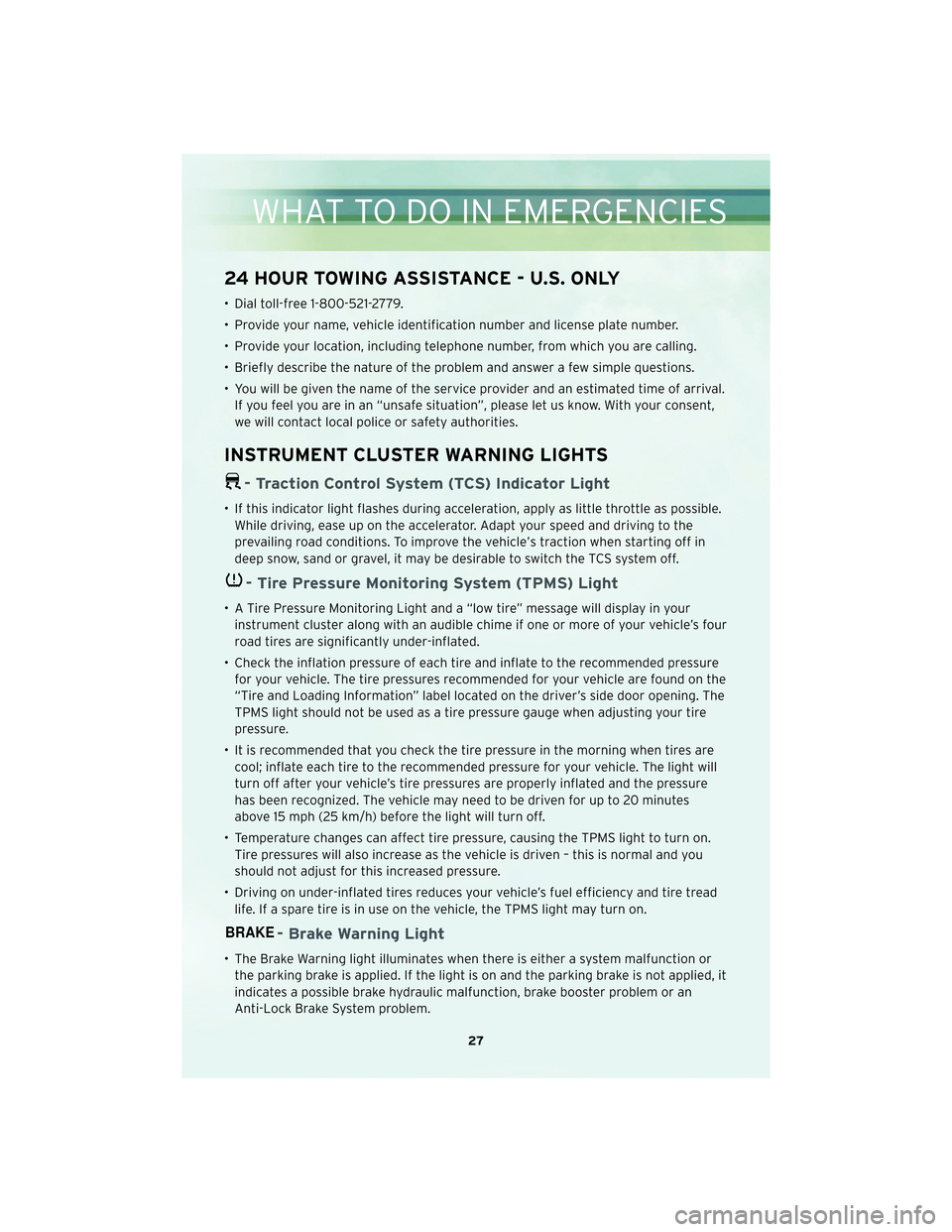
24 HOUR TOWING ASSISTANCE - U.S. ONLY
• Dial toll-free 1-800-521-2779.
• Provide your name, vehicle identification number and license plate number.
• Provide your location, including telephone number, from which you are calling.
• Briefly describe the nature of the problem and answer a few simple questions.
• You will be given the name of the service provider and an estimated time of arrival.If you feel you are in an “unsafe situation”, please let us know. With your consent,
we will contact local police or safety authorities.
INSTRUMENT CLUSTER WARNING LIGHTS
- Traction Control System (TCS) Indicator Light
• If this indicator light flashes during acceleration, apply as little throttle as possible.While driving, ease up on the accelerator. Adapt your speed and driving to the
prevailing road conditions. To improve the vehicle’s traction when starting off in
deep snow, sand or gravel, it may be desirable to switch the TCS system off.
- Tire Pressure Monitoring System (TPMS) Light
• A Tire Pressure Monitoring Light and a “low tire” message will display in yourinstrument cluster along with an audible chime if one or more of your vehicle’s four
road tires are significantly under-inflated.
• Check the inflation pressure of each tire and inflate to the recommended pressure for your vehicle. The tire pressures recommended for your vehicle are found on the
“Tire and Loading Information” label located on the driver’s side door opening. The
TPMS light should not be used as a tire pressure gauge when adjusting your tire
pressure.
• It is recommended that you check the tire pressure in the morning when tires are cool; inflate each tire to the recommended pressure for your vehicle. The light will
turn off after your vehicle’s tire pressures are properly inflated and the pressure
has been recognized. The vehicle may need to be driven for up to 20 minutes
above 15 mph (25 km/h) before the light will turn off.
• Temperature changes can affect tire pressure, causing the TPMS light to turn on. Tire pressures will also increase as the vehicle is driven – this is normal and you
should not adjust for this increased pressure.
• Driving on under-inflated tires reduces your vehicle’s fuel efficiency and tire tread life. If a spare tire is in use on the vehicle, the TPMS light may turn on.
- Brake Warning Light
• The Brake Warning light illuminates when there is either a system malfunction orthe parking brake is applied. If the light is on and the parking brake is not applied, it
indicates a possible brake hydraulic malfunction, brake booster problem or an
Anti-Lock Brake System problem.
27
WHAT TO DO IN EMERGENCIES
Page 32 of 60
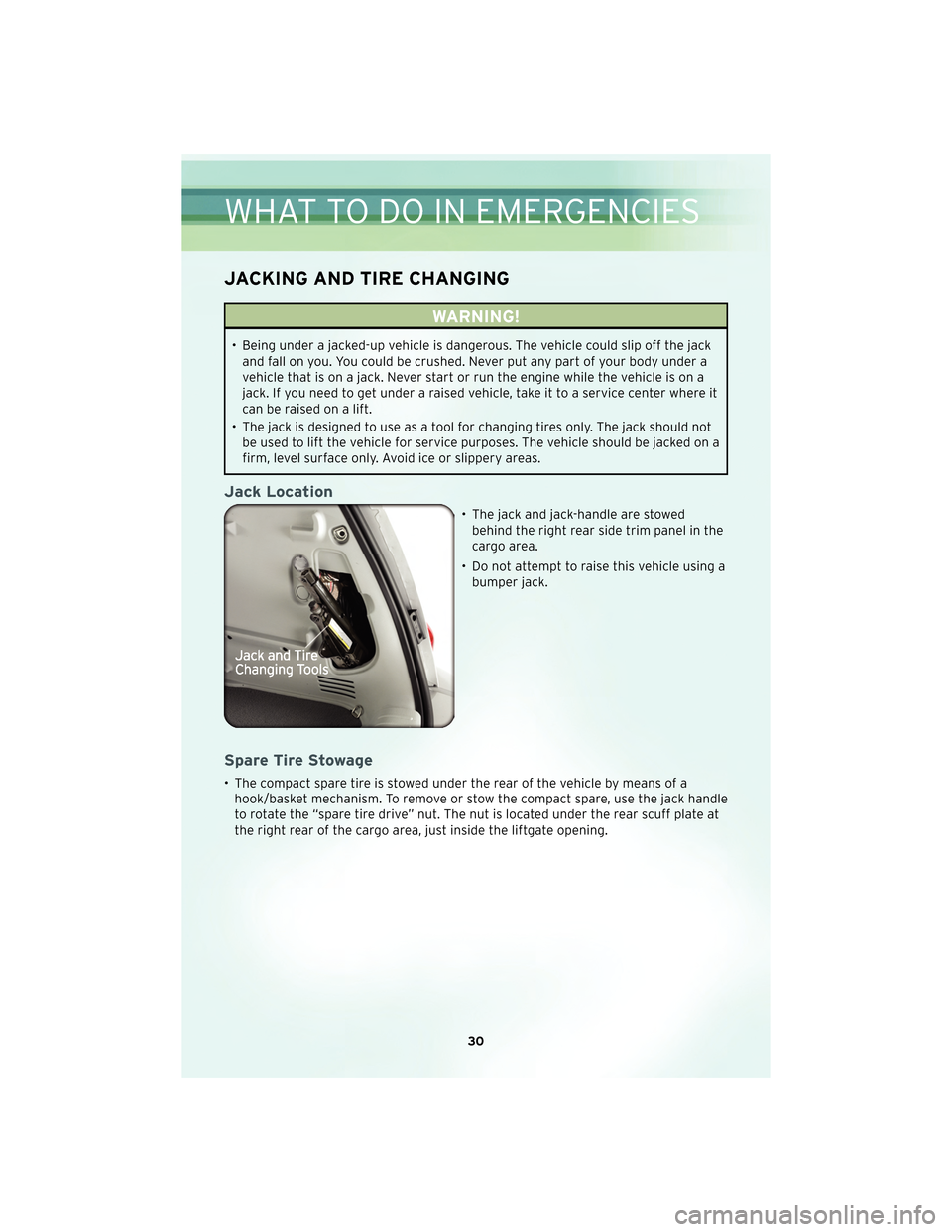
JACKING AND TIRE CHANGING
WARNING!
• Being under a jacked-up vehicle is dangerous. The vehicle could slip off the jackand fall on you. You could be crushed. Never put any part of your body under a
vehicle that is on a jack. Never start or run the engine while the vehicle is on a
jack. If you need to get under a raised vehicle, take it to a service center where it
can be raised on a lift.
• The jack is designed to use as a tool for changing tires only. The jack should not be used to lift the vehicle for service purposes. The vehicle should be jacked on a
firm, level surface only. Avoid ice or slippery areas.
Jack Location
• The jack and jack-handle are stowed behind the right rear side trim panel in the
cargo area.
• Do not attempt to raise this vehicle using a bumper jack.
Spare Tire Stowage
• The compact spare tire is stowed under the rear of the vehicle by means of ahook/basket mechanism. To remove or stow the compact spare, use the jack handle
to rotate the “spare tire drive” nut. The nut is located under the rear scuff plate at
the right rear of the cargo area, just inside the liftgate opening.
WHAT TO DO IN EMERGENCIES
30
Page 34 of 60

• Block both the front and rear of the wheeldiagonally opposite the jacking position.
For example, if changing the right front
tire, block the left rear wheel.
NOTE: Passengers should not remain in the
vehicle while the vehicle is being jacked.
Jacking Instructions
WARNING!
Carefully follow these tire changing warnings to help prevent personal injury or
damage to your vehicle:
• Always park on a firm, level surface as far from the edge of the roadway as possible before raising the vehicle.
• Block the wheel diagonally opposite the wheel to be raised.
• Set the parking brake firmly, and shift the transmission into PARK.
• Never start or run the engine with the vehicle on a jack.
• Do not let anyone sit in the vehicle when it is on a jack.
• Do not get under the vehicle when it is on a jack.
• Only use the jack in the positions indicated and for lifting this vehicle during a tire change.
• If working on or near a roadway, be extremely careful of motor traffic.
• To assure that spare tires, flat or inflated, are securely stowed, spares must be stowed with the valve stem facing the ground.
• Turn on the Hazard Warning flasher.
• Remove the scissors jack and lug wrench from the stowage bag.
NOTE: If equipped with a center cap that covers the wheel nuts, pry off the cap
using the small end of the lug wrench. To reinstall the cap, make sure it is properly
lined up before pushing it onto the wheel.
Loosen, but do not remove, the wheel nuts by turning them to the left one turn while
the wheel is still on the ground.
WHAT TO DO IN EMERGENCIES
32
Page 41 of 60
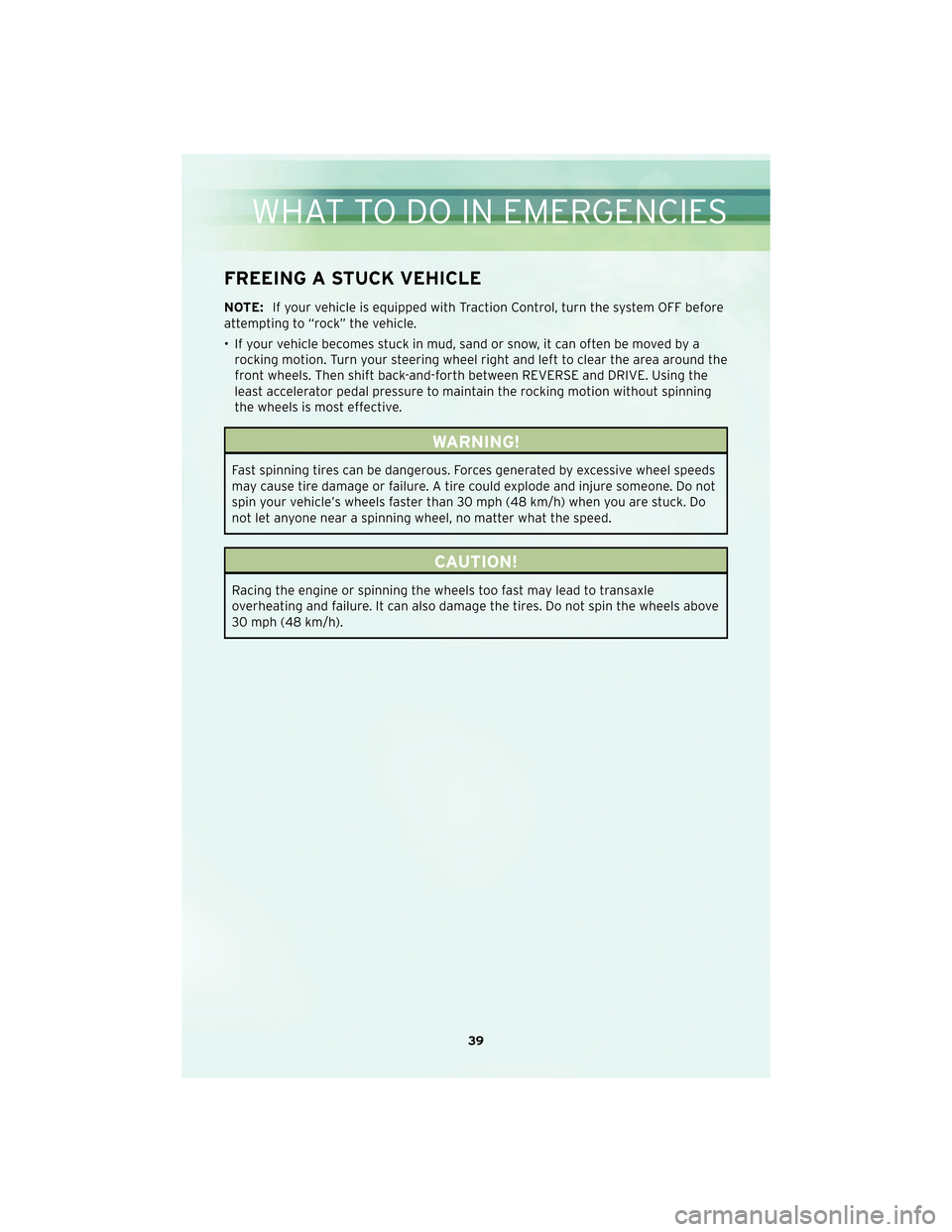
FREEING A STUCK VEHICLE
NOTE:If your vehicle is equipped with Traction Control, turn the system OFF before
attempting to “rock” the vehicle.
• If your vehicle becomes stuck in mud, sand or snow, it can often be moved by a rocking motion. Turn your steering wheel right and left to clear the area around the
front wheels. Then shift back-and-forth between REVERSE and DRIVE. Using the
least accelerator pedal pressure to maintain the rocking motion without spinning
the wheels is most effective.
WARNING!
Fast spinning tires can be dangerous. Forces generated by excessive wheel speeds
may cause tire damage or failure. A tire could explode and injure someone. Do not
spin your vehicle’s wheels faster than 30 mph (48 km/h) when you are stuck. Do
not let anyone near a spinning wheel, no matter what the speed.
CAUTION!
Racing the engine or spinning the wheels too fast may lead to transaxle
overheating and failure. It can also damage the tires. Do not spin the wheels above
30 mph (48 km/h).
39
WHAT TO DO IN EMERGENCIES
Page 46 of 60
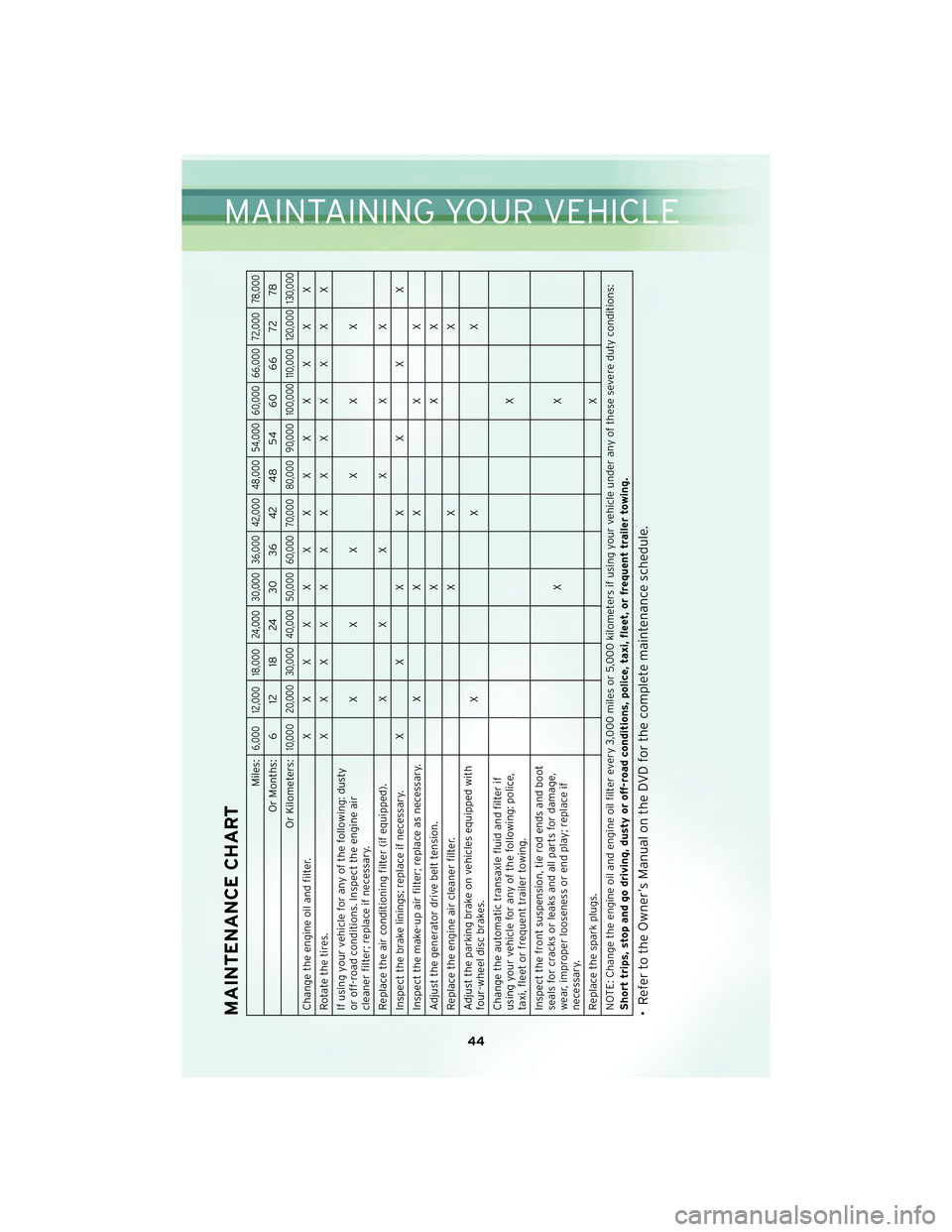
MAINTENANCE CHART
Miles:
6,000 12,000 18,000 24,000 30,000 36,000 42,000 48,000 54,000 60,000 66,000 72,000 78,000
Or Months: 6 12 18 24 30 36 42 48 54 60 66 72 78
Or Kilometers:
10,000 20,000 30,000 40,000 50,000 60,000 70,000 80,000 90,000 100,000 110,000 120,000 130,000
Change the engine oil and filter. XXXXXXXXXXXXX
Rotatethetires. XXXXXXXXXXXXX
If using your vehicle for any of the following: dusty
or off-road conditions. Inspect the engine air
cleaner filter; replace if necessary. XXXXXX
Replace the air conditioning filter (if equipped). X X X X X X
Inspect the brake linings; replace if necessary. X X X X X X X
Inspect the make-up air filter; replace as necessary. X X X X X
Adjust the generator drive belt tension. X X X
Replace the engine air cleaner filter. X X X
Adjust the parking brake on vehicles equipped with
four-wheel disc brakes. XXX
Change the automatic transaxle fluid and filter if
using your vehicle for any of the following: police,
taxi, fleet or frequent trailer towing. X
Inspect the front suspension, tie rod ends and boot
seals for cracks or leaks and all parts for damage,
wear, improper looseness or end play; replace if
necessary. XX
Replace the spark plugs. X
NOTE: Change the engine oil and engine oil filter every 3,000 miles or 5,000 kilometers if using your vehicle under any of these severe duty conditions:
Short trips, stop and go driving, dusty or off-road conditions, police, taxi, fleet, or frequent trailer towing.• Refer to the Owner’s Manual on the DVD for the complete maintenance schedule.
44
MAINTAINING YOUR VEHICLE
Page 49 of 60
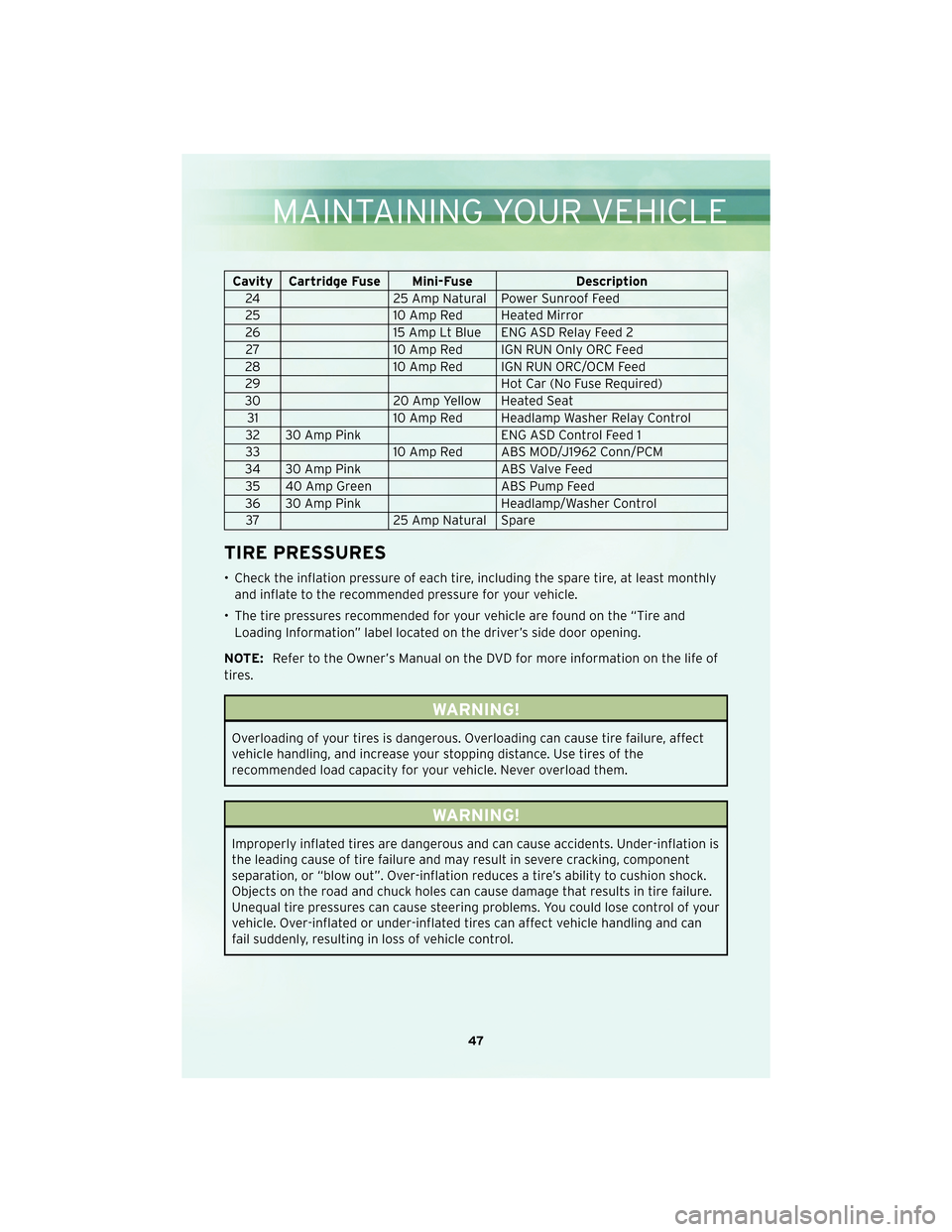
Cavity Cartridge Fuse Mini-FuseDescription
24 25 Amp Natural Power Sunroof Feed
25 10 Amp Red Heated Mirror
26 15 Amp Lt Blue ENG ASD Relay Feed 2
27 10 Amp Red IGN RUN Only ORC Feed
28 10 Amp Red IGN RUN ORC/OCM Feed
29 Hot Car (No Fuse Required)
30 20 Amp Yellow Heated Seat
31 10 Amp Red Headlamp Washer Relay Control
32 30 Amp Pink ENG ASD Control Feed 1
33 10 Amp Red ABS MOD/J1962 Conn/PCM
34 30 Amp Pink ABS Valve Feed
35 40 Amp Green ABS Pump Feed
36 30 Amp Pink Headlamp/Washer Control
37 25 Amp Natural Spare
TIRE PRESSURES
• Check the inflation pressure of each tire, including the spare tire, at least monthly
and inflate to the recommended pressure for your vehicle.
• The tire pressures recommended for your vehicle are found on the “Tire and Loading Information” label located on the driver’s side door opening.
NOTE: Refer to the Owner’s Manual on the DVD for more information on the life of
tires.
WARNING!
Overloading of your tires is dangerous. Overloading can cause tire failure, affect
vehicle handling, and increase your stopping distance. Use tires of the
recommended load capacity for your vehicle. Never overload them.
WARNING!
Improperly inflated tires are dangerous and can cause accidents. Under-inflation is
the leading cause of tire failure and may result in severe cracking, component
separation, or “blow out”. Over-inflation reduces a tire’s ability to cushion shock.
Objects on the road and chuck holes can cause damage that results in tire failure.
Unequal tire pressures can cause steering problems. You could lose control of your
vehicle. Over-inflated or under-inflated tires can affect vehicle handling and can
fail suddenly, resulting in loss of vehicle control.
47
MAINTAINING YOUR VEHICLE
Page 52 of 60
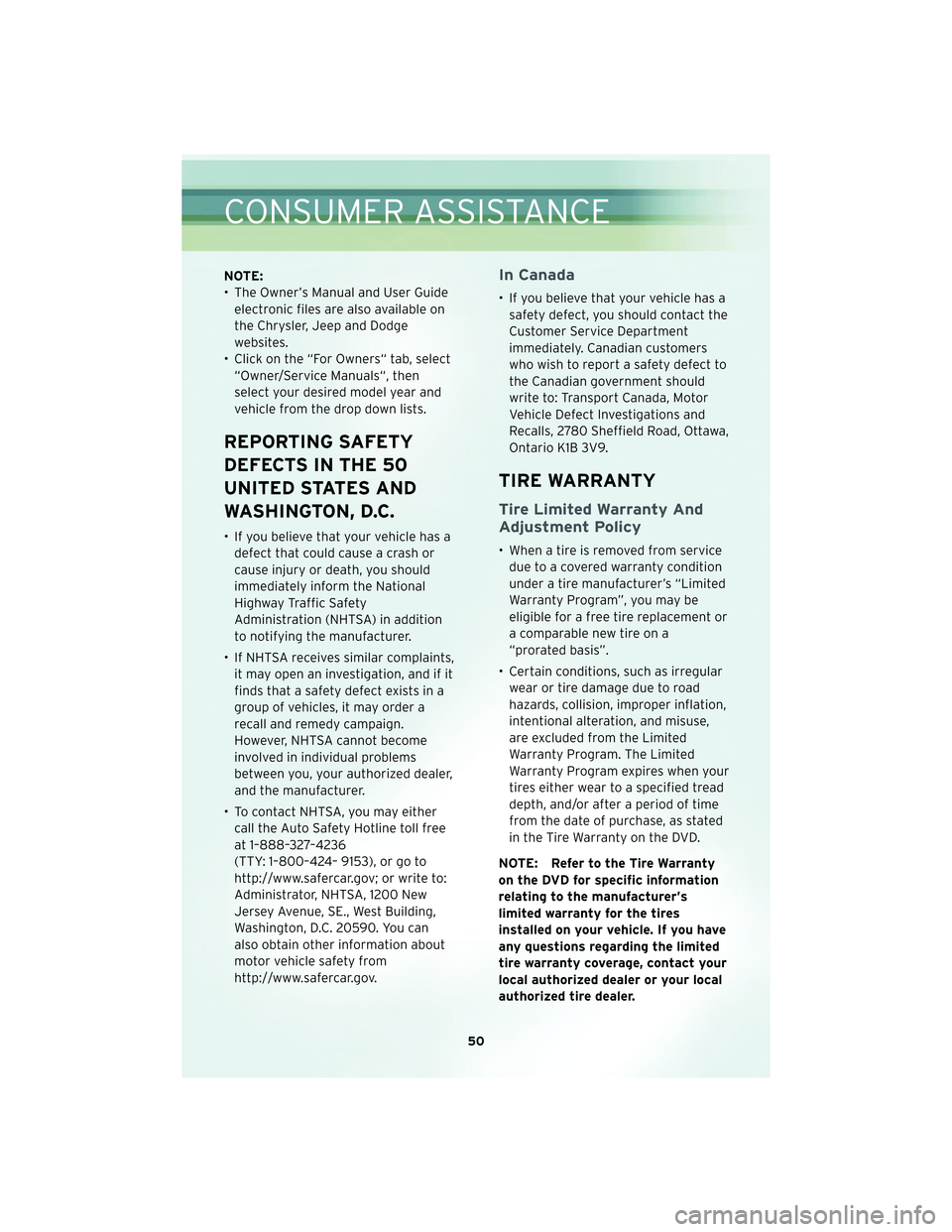
NOTE:
• The Owner’s Manual and User Guideelectronic files are also available on
the Chrysler, Jeep and Dodge
websites.
• Click on the “For Owners“ tab, select “Owner/Service Manuals“, then
select your desired model year and
vehicle from the drop down lists.
REPORTING SAFETY
DEFECTS IN THE 50
UNITED STATES AND
WASHINGTON, D.C.
• If you believe that your vehicle has adefect that could cause a crash or
cause injury or death, you should
immediately inform the National
Highway Traffic Safety
Administration (NHTSA) in addition
to notifying the manufacturer.
• If NHTSA receives similar complaints, it may open an investigation, and if it
finds that a safety defect exists in a
group of vehicles, it may order a
recall and remedy campaign.
However, NHTSA cannot become
involved in individual problems
between you, your authorized dealer,
and the manufacturer.
• To contact NHTSA, you may either call the Auto Safety Hotline toll free
at 1–888–327–4236
(TTY: 1–800–424– 9153), or go to
http://www.safercar.gov; or write to:
Administrator, NHTSA, 1200 New
Jersey Avenue, SE., West Building,
Washington, D.C. 20590. You can
also obtain other information about
motor vehicle safety from
http://www.safercar.gov.
In Canada
• If you believe that your vehicle has asafety defect, you should contact the
Customer Service Department
immediately. Canadian customers
who wish to report a safety defect to
the Canadian government should
write to: Transport Canada, Motor
Vehicle Defect Investigations and
Recalls, 2780 Sheffield Road, O ttawa,
Ontario K1B 3V9.
TIRE WARRANTY
Tire Limited Warranty And
Adjustment Policy
• When a tire is removed from service due to a covered warranty condition
under a tire manufacturer’s “Limited
Warranty Program”, you may be
eligible for a free tire replacement or
a comparable new tire on a
“prorated basis”.
• Certain conditions, such as irregular wear or tire damage due to road
hazards, collision, improper inflation,
intentional alteration, and misuse,
are excluded from the Limited
Warranty Program. The Limited
Warranty Program expires when your
tires either wear to a specified tread
depth, and/or after a period of time
from the date of purchase, as stated
in the Tire Warranty on the DVD.
NOTE: Refer to the Tire Warranty
on the DVD for specific information
relating to the manufacturer’s
limited warranty for the tires
installed on your vehicle. If you have
any questions regarding the limited
tire warranty coverage, contact your
local authorized dealer or your local
authorized tire dealer.
CONSUMER ASSISTANCE
50
Page 53 of 60
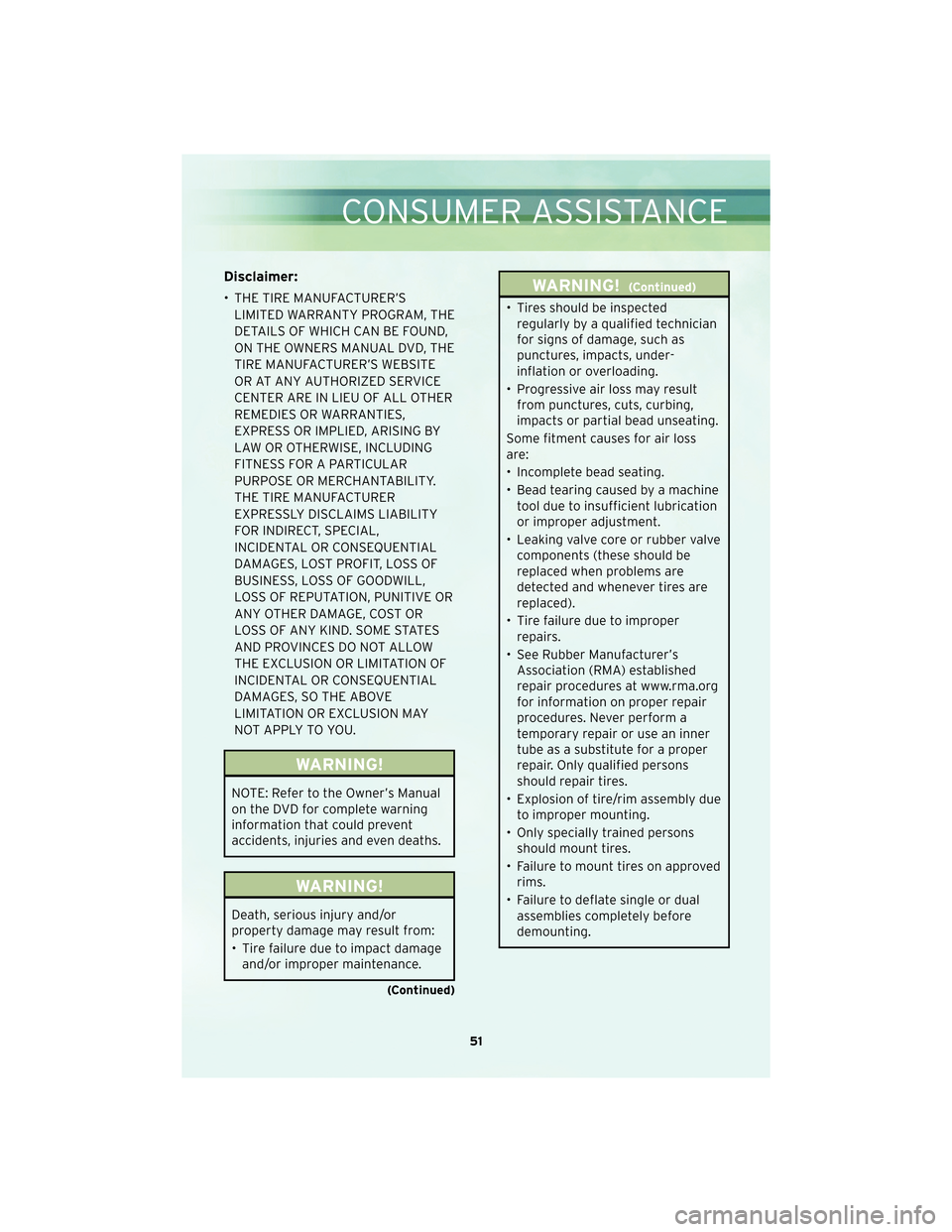
Disclaimer:
• THE TIRE MANUFACTURER’SLIMITED WARRANTY PROGRAM, THE
DETAILS OF WHICH CAN BE FOUND,
ON THE OWNERS MANUAL DVD, THE
TIRE MANUFACTURER’S WEBSITE
OR AT ANY AUTHORIZED SERVICE
CENTER ARE IN LIEU OF ALL OTHER
REMEDIES OR WARRANTIES,
EXPRESS OR IMPLIED, ARISING BY
LAW OR OTHERWISE, INCLUDING
FITNESS FOR A PARTICULAR
PURPOSE OR MERCHANTABILITY.
THE TIRE MANUFACTURER
EXPRESSLY DISCLAIMS LIABILITY
FOR INDIRECT, SPECIAL,
INCIDENTAL OR CONSEQUENTIAL
DAMAGES, LOST PROFIT, LOSS OF
BUSINESS, LOSS OF GOODWILL,
LOSS OF REPUTATION, PUNITIVE OR
ANY OTHER DAMAGE, COST OR
LOSS OF ANY KIND. SOME STATES
AND PROVINCES DO NOT ALLOW
THE EXCLUSION OR LIMITATION OF
INCIDENTAL OR CONSEQUENTIAL
DAMAGES, SO THE ABOVE
LIMITATION OR EXCLUSION MAY
NOT APPLY TO YOU.
WARNING!
NOTE: Refer to the Owner’s Manual
on the DVD for complete warning
information that could prevent
accidents, injuries and even deaths.
WARNING!
Death, serious injury and/or
property damage may result from:
• Tire failure due to impact damageand/or improper maintenance.
(Continued)
WARNING!(Continued)
• Tires should be inspectedregularly by a qualified technician
for signs of damage, such as
punctures, impacts, under-
inflation or overloading.
• Progressive air loss may result from punctures, cuts, curbing,
impacts or partial bead unseating.
Some fitment causes for air loss
are:
• Incomplete bead seating.
• Bead tearing caused by a machine tool due to insufficient lubrication
or improper adjustment.
• Leaking valve core or rubber valve components (these should be
replaced when problems are
detected and whenever tires are
replaced).
• Tire failure due to improper repairs.
• See Rubber Manufacturer’s Association (RMA) established
repair procedures at www.rma.org
for information on proper repair
procedures. Never perform a
temporary repair or use an inner
tube as a substitute for a proper
repair. Only qualified persons
should repair tires.
• Explosion of tire/rim assembly due to improper mounting.
• Only specially trained persons should mount tires.
• Failure to mount tires on approved rims.
• Failure to deflate single or dual assemblies completely before
demounting.
51
CONSUMER ASSISTANCE
Page 54 of 60
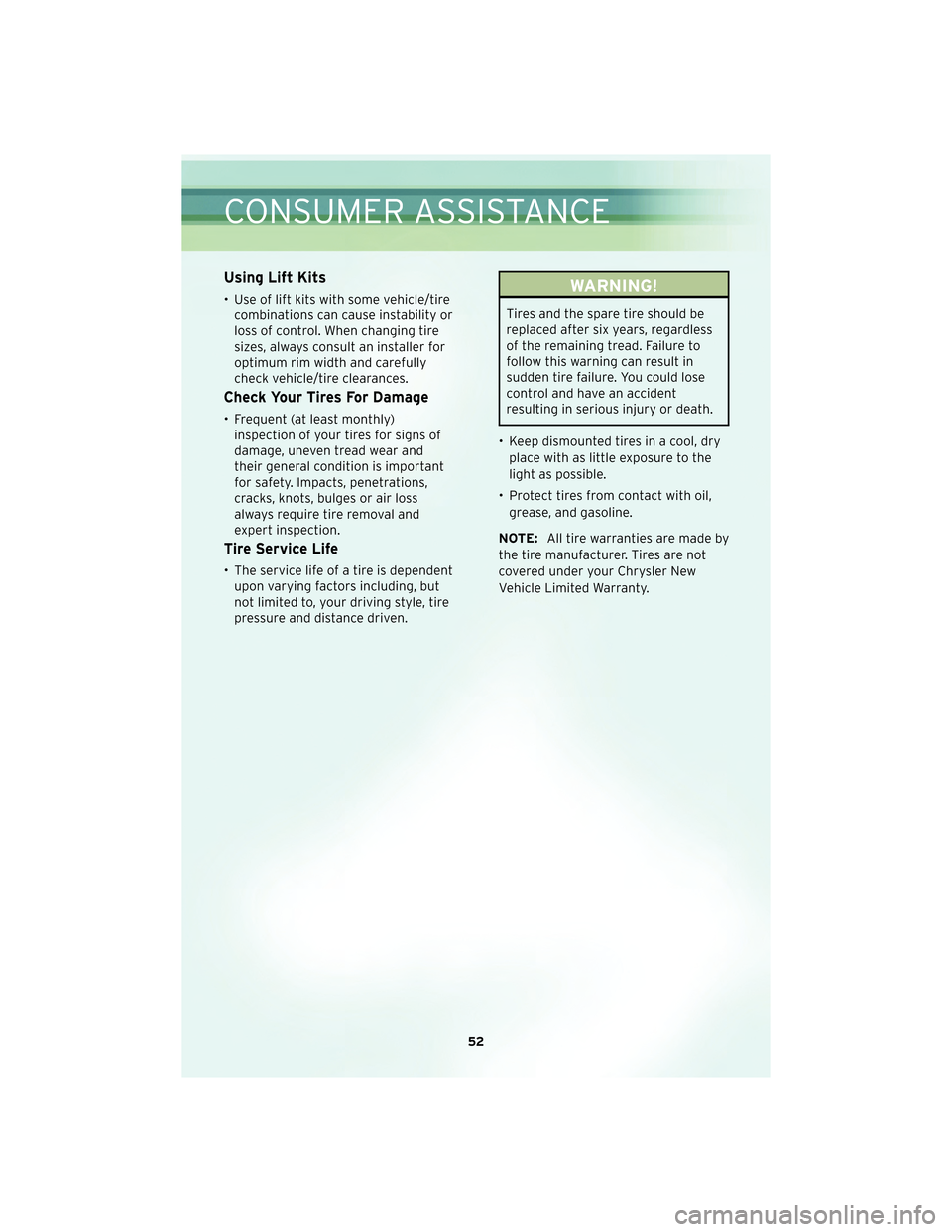
Using Lift Kits
• Use of lift kits with some vehicle/tirecombinations can cause instability or
loss of control. When changing tire
sizes, always consult an installer for
optimum rim width and carefully
check vehicle/tire clearances.
Check Your Tires For Damage
• Frequent (at least monthly)inspection of your tires for signs of
damage, uneven tread wear and
their general condition is important
for safety. Impacts, penetrations,
cracks, knots, bulges or air loss
always require tire removal and
expert inspection.
Tire Service Life
• The service life of a tire is dependentupon varying factors including, but
not limited to, your driving style, tire
pressure and distance driven.
WARNING!
Tires and the spare tire should be
replaced after six years, regardless
of the remaining tread. Failure to
follow this warning can result in
sudden tire failure. You could lose
control and have an accident
resulting in serious injury or death.
• Keep dismounted tires in a cool, dry place with as little exposure to the
light as possible.
• Protect tires from contact with oil, grease, and gasoline.
NOTE: All tire warranties are made by
the tire manufacturer. Tires are not
covered under your Chrysler New
Vehicle Limited Warranty.
CONSUMER ASSISTANCE
52